Music-Crash-Course-Notes-Rests-TIME-Beats
Intro
Written music specifies to the musician(s):
Which pitches to perform (indicated by notes), and when not to perform (indicated by rests)
When to perform notes and rests, indicated by horizontal placement on the stave and
How long to sustain each note or rest.
How long to sustain each note or rest (Length) is indicated within the individual symbols for each note or rest.
Which pitches to perform (indicated by notes), and when not to perform (indicated by rests)
When to perform notes and rests, indicated by horizontal placement on the stave and
How long to sustain each note or rest.
How long to sustain each note or rest (Length) is indicated within the individual symbols for each note or rest.
Notes, Rests, and Time
Here are some of the symbols used for notes and rests.
Each of these symbols have a consistent relationship to each other and to time signatures.
These pictures are enlarged (they appear much smaller when used in normal notation).
Each note is labeled with it's name.
All complete, properly written measures contain notes and rests whose values, when added together equal the time signature.
The "value" of a note or rest is expressed in it's relationship to a whole unit of time and is contained in it's name.
A whole note and a whole rest have the value "1"; 1 = 1/1 = 1.0
A half note and a half rest have the value 1/2; 1/2 = .5
A quarter note and a quarter note rest: 1/4 = .25
Each of these symbols have a consistent relationship to each other and to time signatures.
These pictures are enlarged (they appear much smaller when used in normal notation).
Each note is labeled with it's name.
 |
Whole Note |  |
Half Note | 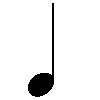 |
Quarter Note |
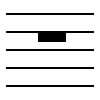 |
Whole Rest | 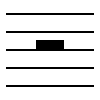 |
Half Rest |  |
Quarter Rest |
All complete, properly written measures contain notes and rests whose values, when added together equal the time signature.
The "value" of a note or rest is expressed in it's relationship to a whole unit of time and is contained in it's name.
A whole note and a whole rest have the value "1"; 1 = 1/1 = 1.0
A half note and a half rest have the value 1/2; 1/2 = .5
A quarter note and a quarter note rest: 1/4 = .25
| 1/4 + 1/4 + 1/4 + 1/4 = 1 | .25 + .25 + .25 + .25 = 1 |
| 1/4 + 1/4 + 1/2 = 1 | .25 + .25 + .5 = 1 |
| 1/4 + 1/2 + 1/4 = 1 | .25 + .5 + .25 = 1 |
| 1/2 + 1/4 + 1/4 = 1 | .5 + .25 + .25 = 1 |
| 1/2 + 1/2 = 1 | .5 + .5 = 1 |
| 1 = 1 | 1 = 1 |
The "value" of a note or rest is expressed in it's relationship to a whole unit of time and is contained in it's name.
A whole note and a whole rest have the value "1"; 1 = 1/1 = 1.0
A half note and a half rest have the value 1/2; 1/2 = .5
A quarter note and a quarter note rest: 1/4 = .25
For your convenience, here's a chart that may help with the 'mathematics' associated with this concept:
Each note is sustained for the it's complete value.
Examples: A whole note is sustained for 1 whole unit of musical TIME,
a half note for 1/2 unit of musical TIME, a quarter note for 1/4 etc..
Here are some examples of these symbols on a stave using the 4/4 time signature. Normally, a clef would be placed at the beginning of each stave to identify pitch (not needed for this particular example).
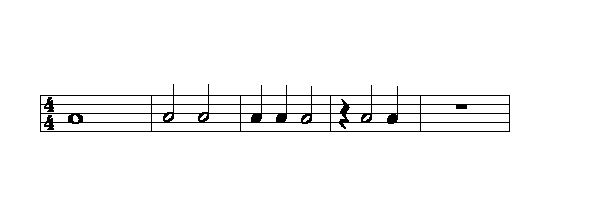
All of the measures in this example contain notes and rests whose values, when added together = 4/4; 4/4 = 1
The first measure of this example contains a whole note. The value of a whole note is 1, which can also be expressed as 1/1 or 1.0; 1/1 = 4/4; 4/4 is the time signature. This measure contains notes and rests whose values, when added together equal the time signature.
The second measure contains two half notes. The value of a half note is 1/2 which can also be expressed as .5. When the values of the two half notes are added together, the measure contains the same total amount of time values as the time signature.
1/2 + 1/2 = .5 +.5 = 1 = 4/4, the time signature.
The third measure contains two quarter notes and one half note.
.25 + .25 + .5 = 1 = 4/4, again the time signature.
The fourth measure: a quarter rest (rest means: perform nothing), half note and quarter note.
.25 + .5 + .25 = 1 = 4/4
Fifth measure: a whole rest. 1 = 4/4

All of the measures in this example contain notes and rests whose values, when added together = 4/4; 4/4 = 1
The first measure of this example contains a whole note. The value of a whole note is 1, which can also be expressed as 1/1 or 1.0; 1/1 = 4/4; 4/4 is the time signature. This measure contains notes and rests whose values, when added together equal the time signature.
The second measure contains two half notes. The value of a half note is 1/2 which can also be expressed as .5. When the values of the two half notes are added together, the measure contains the same total amount of time values as the time signature.
1/2 + 1/2 = .5 +.5 = 1 = 4/4, the time signature.
The third measure contains two quarter notes and one half note.
.25 + .25 + .5 = 1 = 4/4, again the time signature.
The fourth measure: a quarter rest (rest means: perform nothing), half note and quarter note.
.25 + .5 + .25 = 1 = 4/4
Fifth measure: a whole rest. 1 = 4/4
There is an easier method to describe the contents of measures. Describing measures in whole units of time (in relationship to a whole note or whole rest) requires adding numerous decimals or fractions, which becomes tedious. In order to simplify the process, measures are more often described by beats.
Describing by beats means changing the value "1" from one whole unit of musical time to the bottom number of the time signature.
For example: Using the 4/4 time signature, there are four beats to the measure (top number of the time signature) and a quarter value is the beat (bottom number of the time signature).
Here's another look at the previous example:

Describing by the beat, the second measure contains two half notes which, in 4/4 time each have a 'beat value' of 2; together 2 + 2 = 4 beats. The second measure contains notes and rests whose beat values, when added together = 4. There are four beats to the measure.
The third measure contains two quarter notes and one half note.
Described using beats: 1 + 1 + 2 = 4 again, four beats to the measure.
The fourth measure: a quarter rest, half note and quarter note.
1 + 2 + 1 = 4
Fifth measure: a whole rest. 4 = 4
Describing by beats means changing the value "1" from one whole unit of musical time to the bottom number of the time signature.
For example: Using the 4/4 time signature, there are four beats to the measure (top number of the time signature) and a quarter value is the beat (bottom number of the time signature).
Here's another look at the previous example:

Describing by the beat, the second measure contains two half notes which, in 4/4 time each have a 'beat value' of 2; together 2 + 2 = 4 beats. The second measure contains notes and rests whose beat values, when added together = 4. There are four beats to the measure.
The third measure contains two quarter notes and one half note.
Described using beats: 1 + 1 + 2 = 4 again, four beats to the measure.
The fourth measure: a quarter rest, half note and quarter note.
1 + 2 + 1 = 4
Fifth measure: a whole rest. 4 = 4
Here's a chart comparing whole units of time and two examples using beats. In this chart the Quarter and Eighth are used as examples: Their time signatures would have 4 as the bottom number (Quarter) and 8 as the bottom number (Eighth).
| X/1 | X/4 | X/8 |
| Whole Unit of Time = 1 | One Beat = 1/4 | One Beat = 1/8 |
| Whole =1 | Whole = 4 | Whole = 8 |
| Half = 1/2 | Half = 2 | Half = 4 |
| Quarter = 1/4 | Quarter = 1 | Quarter = 2 |
| Eight = 1/8 | Eighth = 1/2 | Eight = 1 |
How long to sustain each note or rest (Length) is indicated within the individual symbols for each note or rest.
Each note is sustained for the it's complete value.
Examples: A whole note is "held" for four complete beats in 4/4 time, a half note for two, a quarter note for one.
Each note is sustained for the it's complete value.
Examples: A whole note is "held" for four complete beats in 4/4 time, a half note for two, a quarter note for one.
Because the time signatures, notes and rests indicate TIME, there is no need for exact spacing between these musical symbols. In fact, time signatures, notes and rests should never be placed so close to each other that they appear to be connected, which could happen if they were always exactly evenly spaced.
Here is another example of the notation of TIME, this time signature is 3/4.
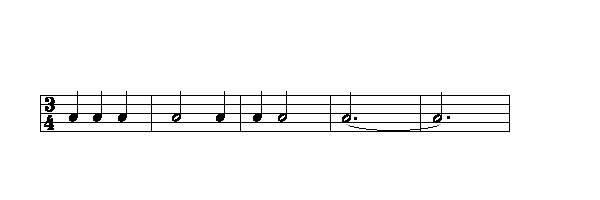
All of the measures in this example contain notes whose values, when added together equal the time signature.
The first measure contains three quarter notes. The quarter value equals 1 beat in 3/4 TIME.
1+1+1=3. Each measure in 3/4 TIME contains 3 beats.
The second measure contains one half note and one quarter note.
2+1=3
The third measure contains one quarter notes and one half note.
1+2=3
The fourth and fifth measures introduce two new musical symbols: the tie and the dot.

All of the measures in this example contain notes whose values, when added together equal the time signature.
The first measure contains three quarter notes. The quarter value equals 1 beat in 3/4 TIME.
1+1+1=3. Each measure in 3/4 TIME contains 3 beats.
The second measure contains one half note and one quarter note.
2+1=3
The third measure contains one quarter notes and one half note.
1+2=3
The fourth and fifth measures introduce two new musical symbols: the tie and the dot.
The tie and the dot serve similar functions. They both are used to extend the value of notes; Only dots are used to extend the value of rests.
When a tie or dot is used depends on the context
A tie connects two notes together to tell the reader "sustain this pitch for the length of both of the note values added together". Ties are the only way to indicate that a pitch is to be held across a measure line. Ties are also used within measures.
A dot is placed just to the right of a note and tells the reader to "sustain this pitch (or rest) for the length of the note (or rest) plus 1/2 the value of the note". Because all complete, properly written measures contain notes and rests whose values, when added together equal the time signature, dots are never used to indicate time values across measure lines.
Measure four in the example above, has a half note with a dot.
A half note in 3/4 TIME has the time value of 2 beats. 2 + (2/2) = 2+1=3 their are three beats to the measure in 3/4 time signature.
This dotted half note is also tied to the dotted half note in the fifth measure. The total length of the pitch is equal to two full measures (in 3/4 time) or 6 beats (1.5 whole units of TIME)
When a tie or dot is used depends on the context
A tie connects two notes together to tell the reader "sustain this pitch for the length of both of the note values added together". Ties are the only way to indicate that a pitch is to be held across a measure line. Ties are also used within measures.
A dot is placed just to the right of a note and tells the reader to "sustain this pitch (or rest) for the length of the note (or rest) plus 1/2 the value of the note". Because all complete, properly written measures contain notes and rests whose values, when added together equal the time signature, dots are never used to indicate time values across measure lines.
Measure four in the example above, has a half note with a dot.
A half note in 3/4 TIME has the time value of 2 beats. 2 + (2/2) = 2+1=3 their are three beats to the measure in 3/4 time signature.
This dotted half note is also tied to the dotted half note in the fifth measure. The total length of the pitch is equal to two full measures (in 3/4 time) or 6 beats (1.5 whole units of TIME)
Here are more of the symbols that are used to indicate notes and rests. They represent even smaller subdivisions of a whole unit of time than those already introduced. As before, these pictures are enlarged (they appear much smaller when used in normal notation). Each symbol is labeled with it's name.
The eighth note and sixteenth notes are visually different from a quarter note because of their flags. Their flags are attached to their stems. An eighth note has one flag, the sixteenth has two.
In order to make the notation easier to read, consecutive notes with flags are often "beamed" together. Beamed notes are joined by one or more lines at the end of the stem which replaces the flag(s) of the notes.
A single line connecting two or more notes at the end of the stem indicates that all of the beamed notes are eighth notes. Pictured is one example of two eighth notes beamed together.
A double line connecting two or more notes at the end of the stem indicates that all of the beamed notes are sixteenth notes. Pictured is one example of two sixteenth notes beamed together.
Combinations of single and double beams are also used.
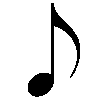 |
Eighth Note | 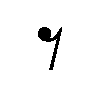 |
Eighth Rest |
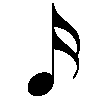 |
Sixteenth Note |  |
Sixteenth Rest |
The eighth note and sixteenth notes are visually different from a quarter note because of their flags. Their flags are attached to their stems. An eighth note has one flag, the sixteenth has two.
In order to make the notation easier to read, consecutive notes with flags are often "beamed" together. Beamed notes are joined by one or more lines at the end of the stem which replaces the flag(s) of the notes.
 |
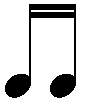 |
Combinations of single and double beams are also used.

